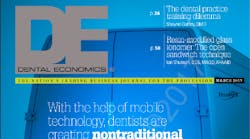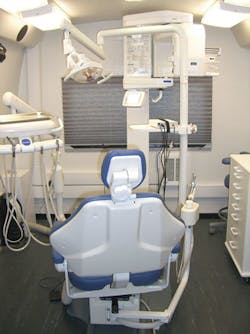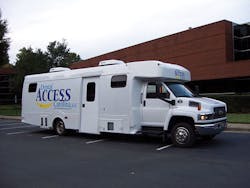Mobile dentistry: Do well while doing good
Through advances in mobile dentistry technology, you can do a good service for people—and make a living while doing it
Editor's note: This is part one of a two-part series. Part two will appear in April 2017.
In my February 2009 Dental Economics article"Mobile Dentistry Done Right," I stated that improving access to care had been the battle cry for organized dentistry since 2000, when the US Surgeon General gave a failing grade to dentistry for meeting the needs of the population. Now, eight years after my first article and 17 years after the 2000 report, access to care is still being discussed.
In 2009, I posited that one of the best ways to improve access to care was to expand the number of providers who properly and ethically employ mobile dental clinics. Mobile clinics take our services to the people, removing the major barriers to access for those who are least likely to receive care by traditional means. Sadly, the "establishment" in dentistry still fails to recognize the value of mobile dentistry and its impact on improving access to care in a variety of arenas, not the least of which are the low-income and elderly populations.
In 2016, the Affordable Care Act offered grant monies for federally qualified health centers to purchase mobile clinics to improve access for the populations they serve. This action was recognition of the opportunity to improve access and a step in the right direction. Unfortunately, if history is a guide, many of these clinics obtained with federal grant money will end up gathering dust after a period of time unless their users find a way to operate them using sound business principles, a talent not typically found in government or quasi-government organizations-thus perpetuating the myth that "mobile dentistry doesn't work."
For-profit mobile clinics work
Enter the private "for-profit" mobile clinic, which functions in exactly the same way as the traditional dental office in terms of business operations. Like 99% of practices, these organizations neither receive grant money nor rely on third-party sources to cover expenses. By employing sound business principles and efficient systems, the goals of serving those in need and earning a respectable living can both be accomplished!
No major paradigm shift has ever been offered by someone who has spent his or her life in the field where the shift occurred. E-mail? The US Postal Service never saw that one coming! The same is true with the access-to-care issue in dentistry. The powers that be are trying to fit a real problem of today into a box built at least 100 years ago. Just as e-mail and social media have changed the way people communicate, and online shopping has changed the way people buy goods and services, mobile dentistry has changed-and will continue to change-the way people access dental care.
Our mobile dental practice, Dental Access Carolina LLC (DAC), has a 16-year proven track record of success in providing ethical, high-quality dental care to economically disadvantaged patients and generating a reasonable living for my staff and my family. Unfortunately, my efforts and the efforts of others have largely been ignored by the established dental community. We have failed to break the traditional mindset of delivering dental care that has been in place for more than a century. This may be because many dentists live in more affluent areas and treat very few Medicaid-eligible patients, so they do not have a good understanding of the problems preventing access to care for that population.
In addition to an emerging new mode of delivering dental care, the mindset of those who are charged with delivering that care is also changing. New dentists today are less likely to practice in traditional settings, and in my opinion, more likely to have an altruistic spirit than their predecessors. The reasons for the shift in practice settings are many, but most of the millennial generation are saddled with massive student loan debts. Even so, I have seen many disparage the profit-driven practices of their predecessors in deference to providing service to those in need. Unfortunately, those two conditions collide when it comes to economics. The new dentists must make enough money to repay their student loans, and they feel they cannot give back until that issue is solved. As a result, many opt for associateships with guaranteed incomes in large corporate practices, where some feel as if they are selling their souls by "feeding the corporate monster" in order to survive. In many cases, this leads to significant professional dissatisfaction because the dentist feels trapped.
The many benefits of our model
Enter our way of practicing dentistry: DAC has developed a model of providing high-quality, continuing comprehensive care to economically disadvantaged patients at schools during school hours, using fully equipped mobile dental clinics designed specifically for us. We are the true "dental home" for the patients we serve because, unlike traditional practices, we can continue our services to them when they move from one school district-or even from one end of the state-to another. We are not hampered by the barriers of transportation, compliance, and scheduling issues that plague most low-income patients and have a direct negative impact on traditional practices. We have been successful in providing consistent care for thousands of patients every year, from pre-kindergarten through high school graduation, during our more than 15 years of operation. We took a free-enterprise approach to a public health problem and the result is that everyone wins-most importantly, the patients!
Because of our mobile capabilities, we are better equipped to provide care on a regular basis than traditional practices. The myth that providing care to low-income patients is not a viable business proposition has been disproven by us, as has the myth that high volume modes of practice are the only way to be profitable in the Medicaid arena. As one of our doctors, James Hicks, DDS, states, "The most common model for dealing with the low-income patient base relies on volume to reach production goals. The schedule is essentially 'overbooked' significantly to compensate for high cancellation rates and no-show patients. This consistently results in a very busy schedule with limited time per patient. Treatment is almost always completed piecemeal, or begun and not completed in complex cases because of the multitude of required appointments. With our model, we see fewer patients but complete more treatment in a shorter time, in large part because we see one patient at a time. The appointment length and amount of treatment completed depends primarily on patient compliance and comfort level and can be tailored to the individual. Patients are significantly benefited by this model. Primarily, more complex procedures such as root canal treatment are routinely performed on teeth that would doubtless be extracted in most other practices due to the time required to complete the treatment."
Dr. Hicks goes on to explain, "We also enjoy a much higher compliance rate from patients. This, I am certain, is due to the amount of time we can spend building trust. We are able to complete more treatment simply because our patients are more comfortable and at ease during the average appointment [which is done without the use of sedation, nitrous, or restraints]. From the standpoint of the clinician, this is invaluable. We are not rushed or forced to treat 'what hurts more,' and we are not bound by an appointment schedule. This enables the symptomatic patient to be rendered pain free, with the remaining treatment completed at the next visit."
Before coming to work with us at DAC, Dr. Hicks had experience in the alternative model he described above, and, when talking about our practice, he says, "It is a blessing to truly focus on patient care with no front office or scheduling pressure. The population we are seeing has no shortage of restorative needs. Being able to quickly assess and maximize treatment needs in as few visits as possible is the only way to properly deliver care to these individuals, and avoid having them fall through the cracks."
In the next part of this series, we will outline the keys to our success and how we have been able to go where others fear to tread!
John E. Reese III, DMD, graduated from the Medical University of South Carolina in 1988. In January 2001, he founded Dental Access Carolina LLC, a mobile dental practice. When his success was proven, he designed his own mobile clinic and now markets them internationally. He also offers consulting on dental practice management. To learn more, please visit dentalaccess.com.
RECOMMENDED:Challenges and potential rewards from mobile dentistry


